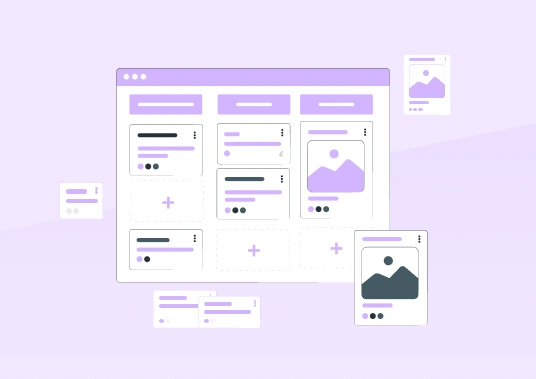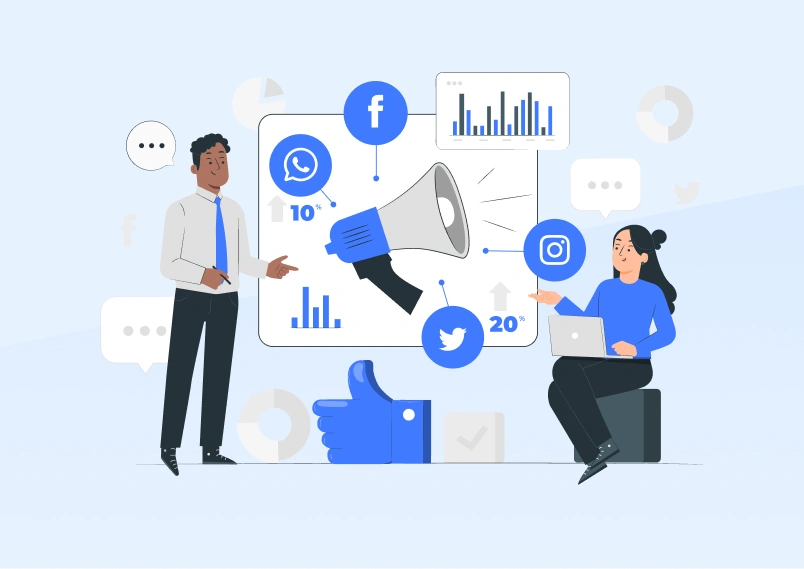Table of Contents
- Addressing Reporting Challenges in Digital Marketing
- Facebook / Meta Ads Strategies that Skyrocket Conversions
- 1.Have a Clear Ad Objective
- Select the Right Objective
- Align with Business Strategies
- Define Success Metrics
- 2.Understand Your Audience
- Create Detailed Buyer Personas
- Leverage Facebook Audience Insights
- Segment Your Audience
- 3. Get Targeting and Placement Right
- Use Custom Audiences
- Leverage Lookalike Audiences
- Choose Optimal Placements
- 4. Craft Compelling Ad Copy and Visuals
- Design Eye-catching Visuals
- Write Persuasive Copy
- Test Multiple Elements
- 5. Optimize Landing Pages for Conversions
- Ensure Mobile-Friendliness
- Maintain Consistency
- Simplify Conversion Paths
- 6. Understand Your Budget and Bidding
- Start with a Testing Phase
- Choose Your Bidding Strategy
- Adjust Based on Performance
- 7. Track Analytics and Tweak as You Go
- Utilize Tools Like the DAXRM Meta Ads Dashboard
- Focus on Key Performance Indicators (KPIs)
- Practice Continuous Optimization
- It’s Time for Your Meta Ads to Shine
Addressing Reporting Challenges in Digital Marketing
Did you know that recent Facebook statistics reveal an average click-through rate (CTR) of just 0.9% across all industries? And while the average conversion rate (CVR) is 9.21%, you can exceed these modest figures by a huge margin if you follow the right strategy.

For example:
- Strike Social reported a 28X return on ad spend (ROAS) through data-driven campaign optimization
- Inflow claimed a 785% increase in sales resulting from a carefully articulated Meta ads campaign
- Beachwaver conversions increased 210% after they improved their website’s lighthouse performance score, a rating that Google assigns based on a bunch of factors such as loading time, SEO best practices, and overall experience.
There are countless more examples of campaigns that far outperform Meta averages. So, how can your campaigns achieve such stellar results?
Facebook / Meta Ads Strategies that Skyrocket Conversions
1.Have a Clear Ad Objective
The foundation of any successful ad campaign is a well-defined objective. A clear goal helps streamline the planning and execution process, allowing marketers to craft targeted messages and measure success effectively.
Select the Right Objective
Meta offers a variety of campaign objectives such as brand awareness, reach, traffic, engagement, app installs, video views, lead generation, and conversions. For instance, if your goal is to increase website traffic, choose the "Traffic" objective, which optimizes ads for link clicks. Conversely, if you’re launching a new product, selecting "Conversions" allows you to optimize for purchases directly.
Pro Tip: Experiment with different objectives to see which aligns best with your intended outcomes. For example, use an engagement objective to interact with your audience before launching a conversion-focused campaign.
Align with Business Strategies
Ensure that your chosen ad objective supports your broader marketing and business strategies for synergy across platforms. For example, if your business goal is to expand your online presence, using the "Brand Awareness" objective will help establish recognition that complements your website and social media efforts.
Pro Tip: Map out your yearly marketing goals and confirm how each ad campaign objective aligns with these. You might decide, for instance, that in the first quarter you want to grow your email list, so utilizing "Lead Generation" would take precedence.
Define Success Metrics
Determine how success will be measured—whether through clicks, leads, sales, or another metric. If aiming for conversions, track metrics like cost per acquisition (CPA) and return on ad spend (ROAS). If the goal is engagement, focus on likes, comments, and shares to gauge interest.
Pro Tip: Set specific success metrics. For example, if you're targeting conversions, aim for a 5% conversion rate. Regularly review these metrics and adjust your campaigns based on the performance data.
2.Understand Your Audience
Knowing your audience intimately is crucial for tailoring campaigns that resonate with their interests and needs. A well-defined understanding of who your audience is will significantly improve the relevance and effectiveness of your ads.
Create Detailed Buyer Personas
Develop comprehensive personas that include not only basic demographics such as age, gender, and location but also psychographics like interests, hobbies, values, and online behavior. For instance, if you are selling hiking gear, your buyer persona might include outdoor enthusiasts aged 25-40, who enjoy eco-friendly products and are active on platforms like Instagram and Facebook.
Pro Tip: Use surveys, customer interviews, and social media listening tools to gather data that helps refine these personas. Create at least three to four distinct personas to cover different segments of your target audience.
Leverage Facebook Audience Insights
Use this powerful tool to gather detailed information about your audience's interactions, digital habits, and purchase behaviors. Facebook Audience Insights can show you what kinds of content your audience engages with, their interests, and even demographics beyond what you've listed.
Pro Tip: Look for trends in audience data, such as peak engagement times or popular pages they follow. This insight will guide you in tailoring your ad content and scheduling for maximum impact.
Segment Your Audience
Break your target audience into smaller segments based on similarities in demographics, interests, and behaviors to deliver personalized ad content. For example, create specific ad campaigns for first-time users, loyal customers, or users who have shown interest in certain products.
Pro Tip: Utilize Dynamic Creative Ads to automatically serve different audiences with tailored variations of your ads based on their specific characteristics. This not only enhances relevance but can lead to higher engagement rates and conversions.
3. Get Targeting and Placement Right
Precision in targeting amplifies your ads' effectiveness by ensuring they reach the most relevant audience. The right targeting strategies not only enhance ad visibility but also significantly improve conversion rates.
Use Custom Audiences
These allow you to target individuals who have already engaged with your business, including website visitors, app users, or email subscribers. For instance, create ads specifically for users who visited your product page but did not complete a purchase, enticing them with a reminder or a special discount.
Pro Tip: Implement retargeting ads to re-engage users. Use time-limited offers to create urgency that encourages conversion, such as "Come back and complete your purchase and receive 10% off!"
Leverage Lookalike Audiences
This feature helps you reach new users who share similar characteristics with your best existing customers. For example, if you have a list of your top customers, create a Lookalike Audience based on their demographics and interests to find new prospects who are likely to convert.
Pro Tip: Experiment with different audience sizes when creating Lookalike Audiences. A smaller percentage (e.g., 1%) will be more similar to your existing customers, while a larger percentage (e.g., 5%) will reach a broader but potentially less relevant audience.
Choose Optimal Placements
Utilize Facebook’s automatic placements to let its algorithm determine the best locations for your ads, or manually select placements based on prior performance insights. For example, if you notice that your ads perform significantly better in the Facebook Feed compared to the right column, focus your budget there.
Pro Tip: Monitor your ad performance regularly to identify which placements yield the best results. Consider using the A/B testing feature to compare different placements against one another and adjust your strategy based on data-driven insights.
4. Craft Compelling Ad Copy and Visuals
Effective ad copy and visuals are pivotal in capturing attention and conveying your message quickly. High-quality content not only engages your audience but also drives them toward taking action.
Design Eye-catching Visuals
Use vivid images or videos that align with your brand identity while grabbing the viewer's attention instantly. For example, if you're advertising a travel destination, vibrant images of breathtaking landscapes or immersive video tours can evoke wanderlust and curiosity.
Pro Tip: Incorporate branding elements—such as logos or signature colors—into your visuals for consistency. Consider using motion graphics or animations to stand out in crowded feeds, as studies show that videos can increase engagement by up to 1200%.
Write Persuasive Copy
Shift the focus from features to benefits to emotionally connect with your audience. For instance, instead of stating that a shampoo contains organic ingredients (a feature), emphasize that it nourishes hair for a softer, shinier look (a benefit). Use emotional triggers like urgency (“Limited time offer!”) or fear of missing out (“Join thousands of satisfied customers!”) to motivate action.
Pro Tip: Incorporate power words in your copy—like "exclusive," "boost," and "transform"—to create a sense of excitement. Ensure that every ad concludes with a clear, compelling call to action that instructs viewers on what to do next, such as “Shop Now,” “Sign Up Today,” or “Learn More.”
Test Multiple Elements
A/B testing is crucial for optimizing ad performance. Experiment with different headlines, images, and copies to identify what drives the best results. For example, you might test two different headlines to see which one generates more clicks: “Transform Your Hair Today” versus “The Secret to Stunning Hair Revealed.”
Pro Tip: Monitor the performance of each ad variation over a set period. Use Facebook's built-in A/B testing tools to compare multiple elements simultaneously, and allocate more budget to higher-performing ads. Make adjustments based on data—if a particular image or tone resonates better with your audience, incorporate that into future ads.
5. Optimize Landing Pages for Conversions
Even a highly clicked ad will fail to deliver results without a landing page that is optimized for conversions. The landing page is a crucial touchpoint in the customer journey, and optimizing it can significantly increase your conversion rates.
Ensure Mobile-Friendliness
Given that a substantial portion of Facebook users access the platform via mobile devices, it’s essential to thoroughly optimize your landing pages for mobile experiences. This includes ensuring fast loading times and responsive design that adapts seamlessly to various screen sizes.
Pro Tip: Use tools like Google’s Mobile-Friendly Test to evaluate how well your landing page performs on mobile devices. Consider optimizing image sizes and removing unnecessary elements that may slow down loading speeds. Aim for a target load time of 3 seconds or less.
Maintain Consistency
The messaging and design of your landing page should align closely with the ad that brought users there. This consistency reinforces your brand message and builds trust, reducing bounce rates. For example, if your ad promotes a summer sale on shoes, the landing page should clearly highlight the sale, feature similar products, and reflect the same visual style used in the ad.
Pro Tip: Use the same headlines, imagery, and call-to-action (CTA) language on the landing page as seen in the ad. Conduct user testing to gather feedback on whether users feel the message is consistent and aligned.
Simplify Conversion Paths
Minimize friction in the conversion process by making it as straightforward as possible. Ensure that forms are easy to fill out, and limit the number of fields required to complete a signup or purchase. The call-to-action (CTA) buttons should be prominently displayed and clearly labeled.
Pro Tip: Implement single-column forms that guide users through the signup process with minimal distractions. For instance, if you’re collecting email addresses, only ask for the essentials—like name and email—rather than unnecessary information. Test different button colors and placements to discover what generates the highest click-through rates.
6. Understand Your Budget and Bidding
Effective budget management and strategic bidding are essential for ensuring cost-effectiveness and scalability of your Facebook ad campaigns. A well-planned budget not only maximizes your return on investment (ROI) but also allows for flexibility and growth.
Start with a Testing Phase
Begin by allocating a small budget to experiment with different ad sets and audiences. This phase is essential for gathering data to understand which ads resonate most with your target market. For example, you might allocate $500 to test multiple demographics, interests, and ad creatives over a week.
Pro Tip: Use this testing period to track key metrics such as click-through rates (CTR) and conversion rates for each ad variant. This information will guide your decisions on where to expand your budget in later stages.
Choose Your Bidding Strategy
Depending on your campaign goals, select the most appropriate bidding strategy. For instance, if your primary goal is site traffic, consider using cost-per-click (CPC) bidding. If you aim to maximize impressions or brand awareness, cost-per-impression (CPM) is often more appropriate. For lead generation, cost-per-acquisition (CPA) can help you focus on conversions.
Pro Tip: Review historical data to inform your bidding choices. If previous campaigns indicate that CPC works better for your audience, lean toward that strategy while remaining open to adjustments as needed.
Adjust Based on Performance
After your initial tests, analyze which ads are performing best and allocate additional budget to these high performers. Conversely, reduce investment in underperforming ads to optimize overall spending. For example, if one ad achieves a conversion rate of 10% compared to another's 2%, consider reallocating budget from the lower-performing campaign to enhance its visibility.
Pro Tip: Set aside a portion of your budget for ongoing optimizations. For example, allocate 10-20% as a flexible fund that you can direct toward ads that show promising early indicators, enabling you to capitalize on successful elements quickly.
7. Track Analytics and Tweak as You Go
Continuous analysis and adjustment are essential for maximizing the effectiveness of your Facebook ads. Leveraging data allows you to make informed decisions to enhance performance and achieve better results.
Utilize Tools Like the DAXRM Meta Ads Dashboard
Tools like the DAXRM Meta Ads Dashboard streamline data tracking and reporting, enabling you to analyze critical metrics effortlessly. With DAXRM, you can organize your data visually, making it easier to identify trends and anomalies.
Pro Tip: Set up custom reports to focus on metrics that matter most to your business, such as conversion rates from specific campaigns or audience segments. Regularly check these reports to stay informed about how your campaigns perform over time.
Focus on Key Performance Indicators (KPIs)
Identify and monitor vital KPIs—such as click-through rates (CTR), conversion rates, cost per lead, and overall return on investment (ROI)—to gauge campaign success. For example, if your CTR is significantly lower than the industry average, it may indicate the need for stronger ad copy or visuals.
Pro Tip: Regularly schedule reviews of your KPIs, such as weekly or bi-weekly, to identify trends and make timely adjustments. Use these insights to pivot quickly; if a particular ad or audience segment isn't performing as expected, take action to refine your strategy.
Practice Continuous Optimization
Iteratively optimize ad creatives, targeting, and budget based on the data collected. For instance, if you notice that a specific audience segment responds particularly well to a certain type of imagery or messaging, double down on that approach while phasing out less effective elements.
Pro Tip: Employ A/B testing regularly to test new creatives or strategies. For example, if one version of an ad with a clear image of a product outperforms a different version with a lifestyle shot, use that insight to inform future ad designs. Aim for a cycle of feedback and improvement, where each campaign builds upon lessons learned from the previous ones.
It’s Time for Your Meta Ads to Shine
Now is the time to take action and elevate your Meta ad campaigns to new heights. Start implementing these tips in your next campaign. Set clear objectives and refine your targeting. Use engaging visuals, persuasive copy, and ensure your landing pages are designed for conversion success. Take advantage of tools like the DAXRM Meta Ads Dashboard to simplify your analytics process. By staying on top of your data, you can make informed decisions that fine-tune your approach for maximum effectiveness.
Begin your journey to better results and enhanced ROI by applying these insights and exploring how DAXRM can streamline your ad management. Don’t wait—start transforming your Facebook ad strategy today and watch your conversion rates skyrocket!


